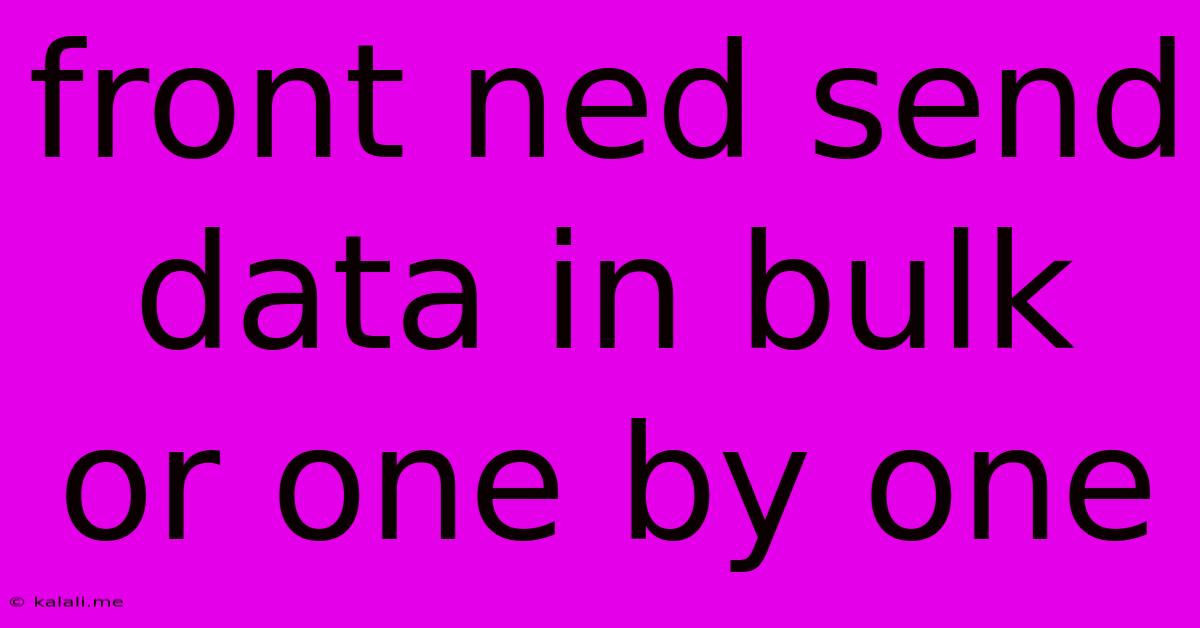Front Ned Send Data In Bulk Or One By One
Kalali
Jun 06, 2025 · 3 min read

Table of Contents
Front-End Sending Data: Bulk vs. One-by-One – Which is Best?
Sending data from the front-end to a back-end server is a fundamental aspect of web development. Whether you're uploading user profiles, processing form submissions, or streaming real-time data, the method you choose significantly impacts performance, efficiency, and the overall user experience. This article explores the key differences between sending data in bulk versus one-by-one, outlining the advantages and disadvantages of each approach. We'll delve into scenarios where each method shines and help you make the right choice for your application.
Understanding the Methods
The core difference lies in how data is transmitted:
-
One-by-One: Data is sent individually, often triggered by a specific user action (e.g., submitting a form field, clicking a button). This is a straightforward approach, suitable for smaller datasets or scenarios where immediate feedback is required after each data point is processed.
-
Bulk: Data is aggregated and sent as a single batch. This is efficient for larger datasets, reducing the number of network requests and potentially improving overall performance. However, it requires more complex handling on both the front-end and back-end.
One-by-One: Advantages and Disadvantages
Advantages:
- Simplicity: Easier to implement and debug.
- Immediate Feedback: Provides immediate responses for each data point, improving user experience for interactive applications.
- Error Handling: Easier to isolate and handle errors for individual data points.
- Suitable for Small Datasets: Ideal when dealing with a small number of data points.
Disadvantages:
- Inefficient for Large Datasets: Many individual requests can lead to network latency and slow down the application.
- Increased Server Load: Numerous requests can put a strain on the server.
- Higher Bandwidth Consumption: Multiple requests consume more bandwidth compared to bulk transfers.
Bulk Data Transfer: Advantages and Disadvantages
Advantages:
- Efficiency for Large Datasets: Significantly reduces the number of network requests, improving performance.
- Reduced Server Load: Fewer requests mean less strain on the server.
- Lower Bandwidth Consumption: Conserves bandwidth by sending data in a single batch.
- Improved Performance: Faster overall data transmission, especially for large datasets.
Disadvantages:
- Increased Complexity: Requires more sophisticated front-end and back-end handling.
- Delayed Feedback: Users might experience a delay before receiving feedback on the entire batch.
- Error Handling: More challenging to handle errors; a single error in the batch could potentially invalidate the entire transfer.
- Potential for Data Loss: If the transfer fails, a significant amount of data might be lost.
Choosing the Right Method: Key Considerations
The best approach depends heavily on your specific application requirements:
-
Dataset Size: For large datasets (e.g., uploading multiple files, large-scale data entry), bulk transfer is usually more efficient. For small datasets, one-by-one might be simpler.
-
Real-time Requirements: If immediate feedback is crucial for each data point (e.g., a live chat application), one-by-one is preferred. For non-real-time scenarios, bulk transfer is often better.
-
Error Handling: Consider how you'll handle errors. One-by-one offers easier error isolation, while bulk transfers require more robust error handling mechanisms.
-
Network Conditions: In environments with unreliable network connections, smaller, more frequent requests (one-by-one) might be more resilient.
Implementation Considerations
Regardless of your chosen method, efficient data handling requires careful consideration of:
- Data Serialization: Use efficient formats like JSON for data representation.
- HTTP Methods: Choose appropriate HTTP methods (POST, PUT) based on your application's needs.
- Error Handling: Implement comprehensive error handling on both the front-end and back-end.
- Progress Indicators: Provide visual feedback to users, especially during large bulk transfers.
By carefully weighing the advantages and disadvantages of each approach and considering the factors above, you can select the optimal method for sending data from your front-end, maximizing efficiency and user experience. Remember to prioritize robust error handling and provide clear feedback to users throughout the data transfer process.
Latest Posts
Latest Posts
-
Can I Put Water In My Coolant
Jun 07, 2025
-
How To Change Light Bulb Ceiling Fan
Jun 07, 2025
-
3 Places In Acts Where Conflict Occurred
Jun 07, 2025
-
1 2 Or 3 4 Water Supply Line
Jun 07, 2025
-
How Long Is A Rotation In Sstar Wars
Jun 07, 2025
Related Post
Thank you for visiting our website which covers about Front Ned Send Data In Bulk Or One By One . We hope the information provided has been useful to you. Feel free to contact us if you have any questions or need further assistance. See you next time and don't miss to bookmark.